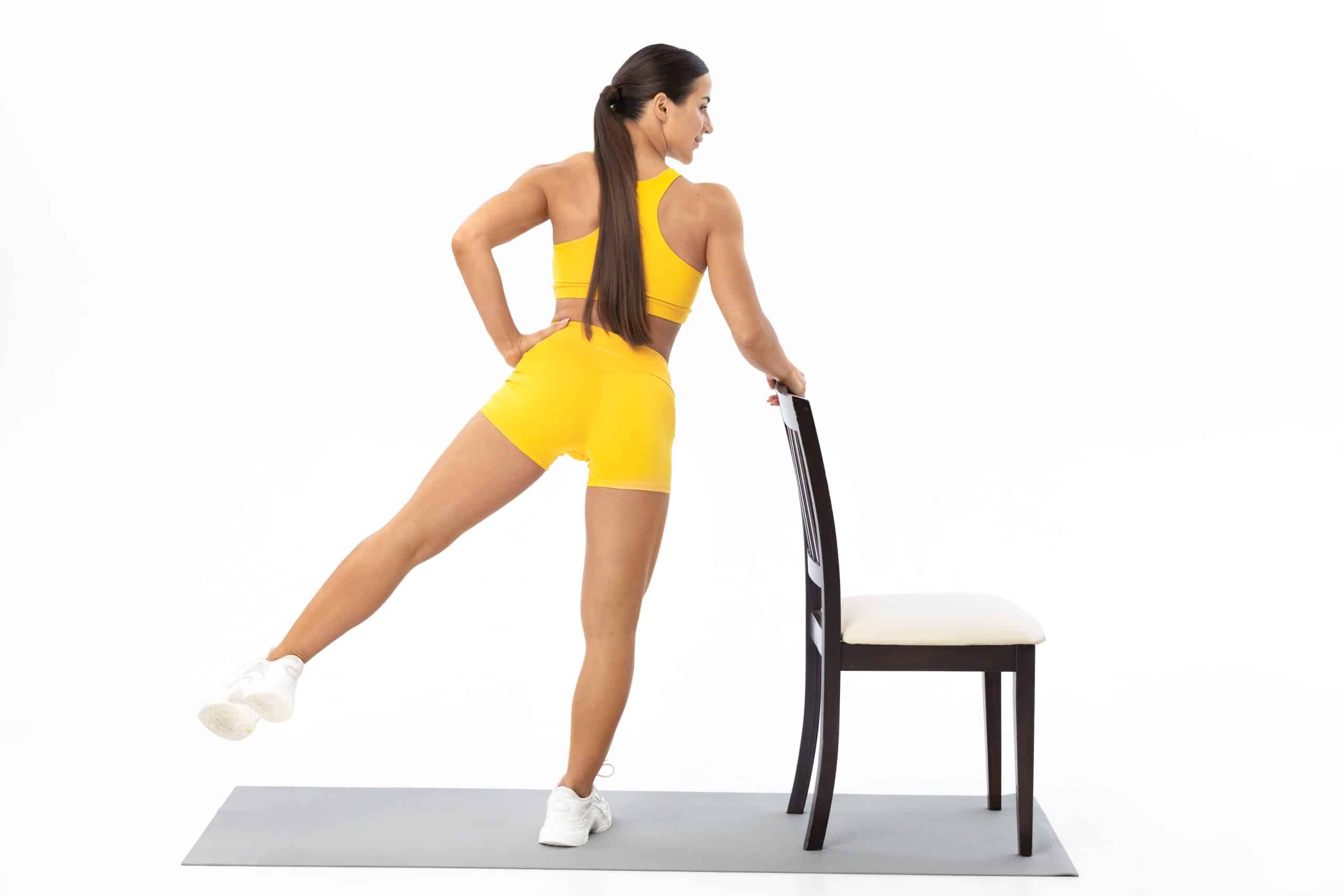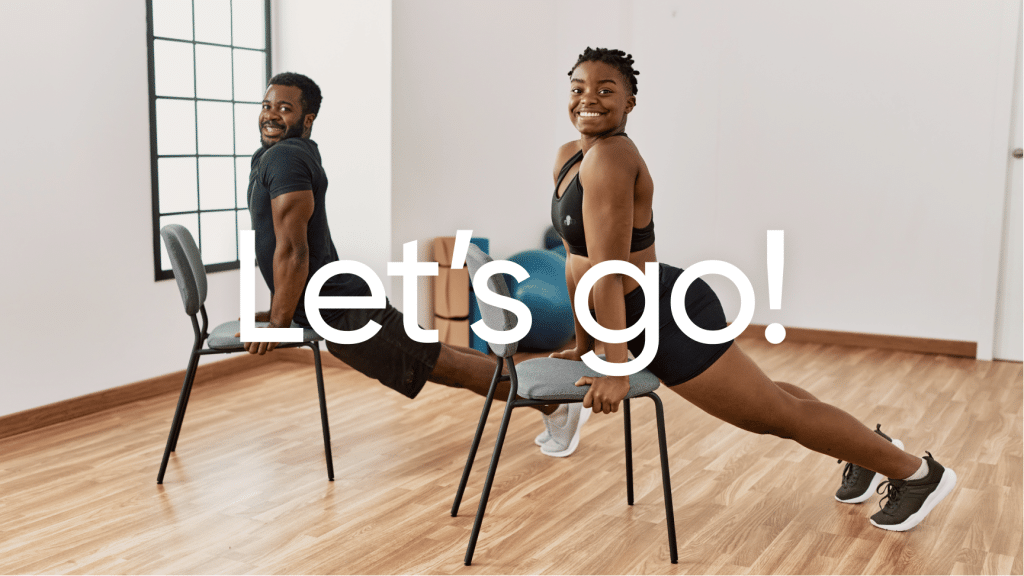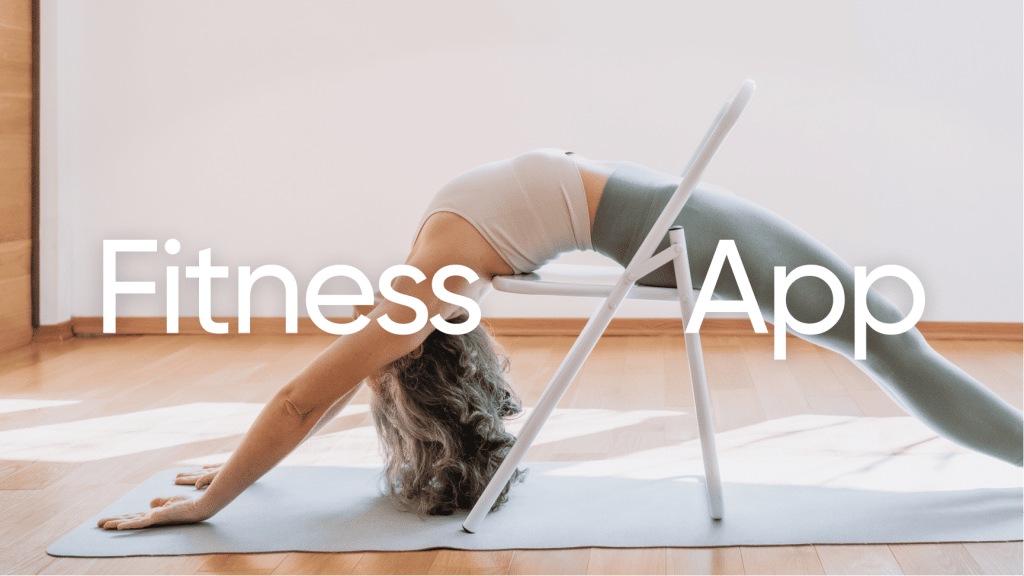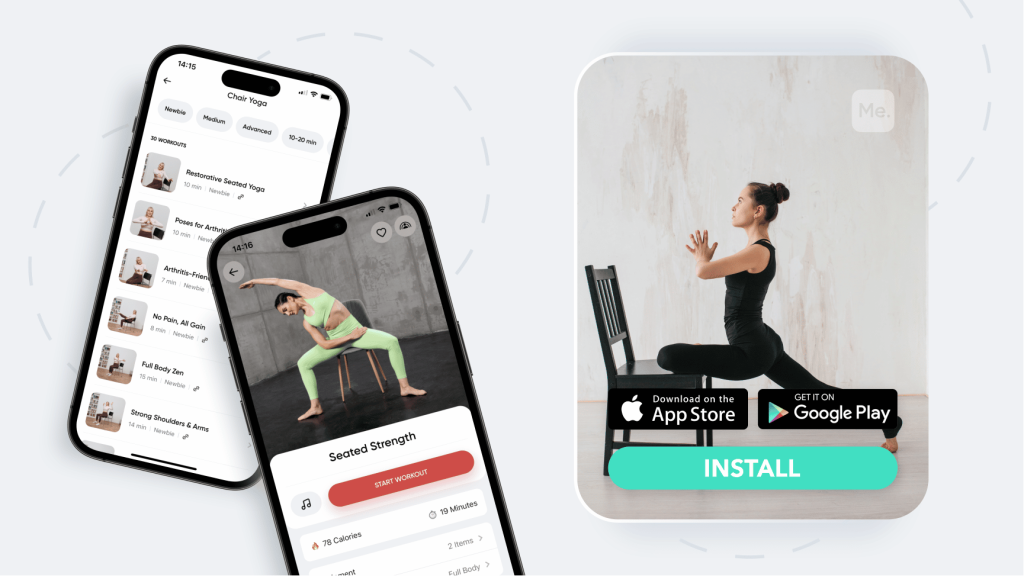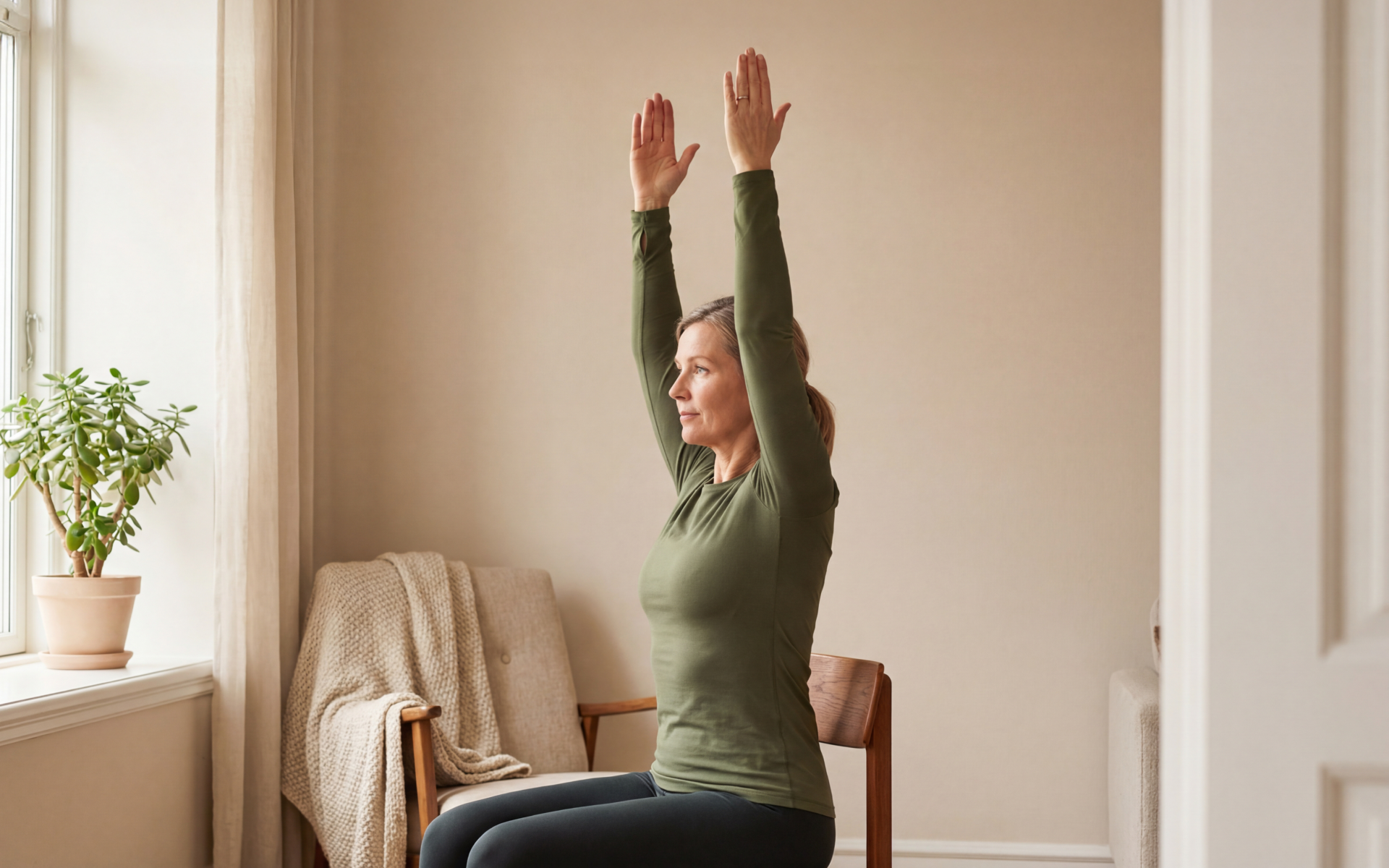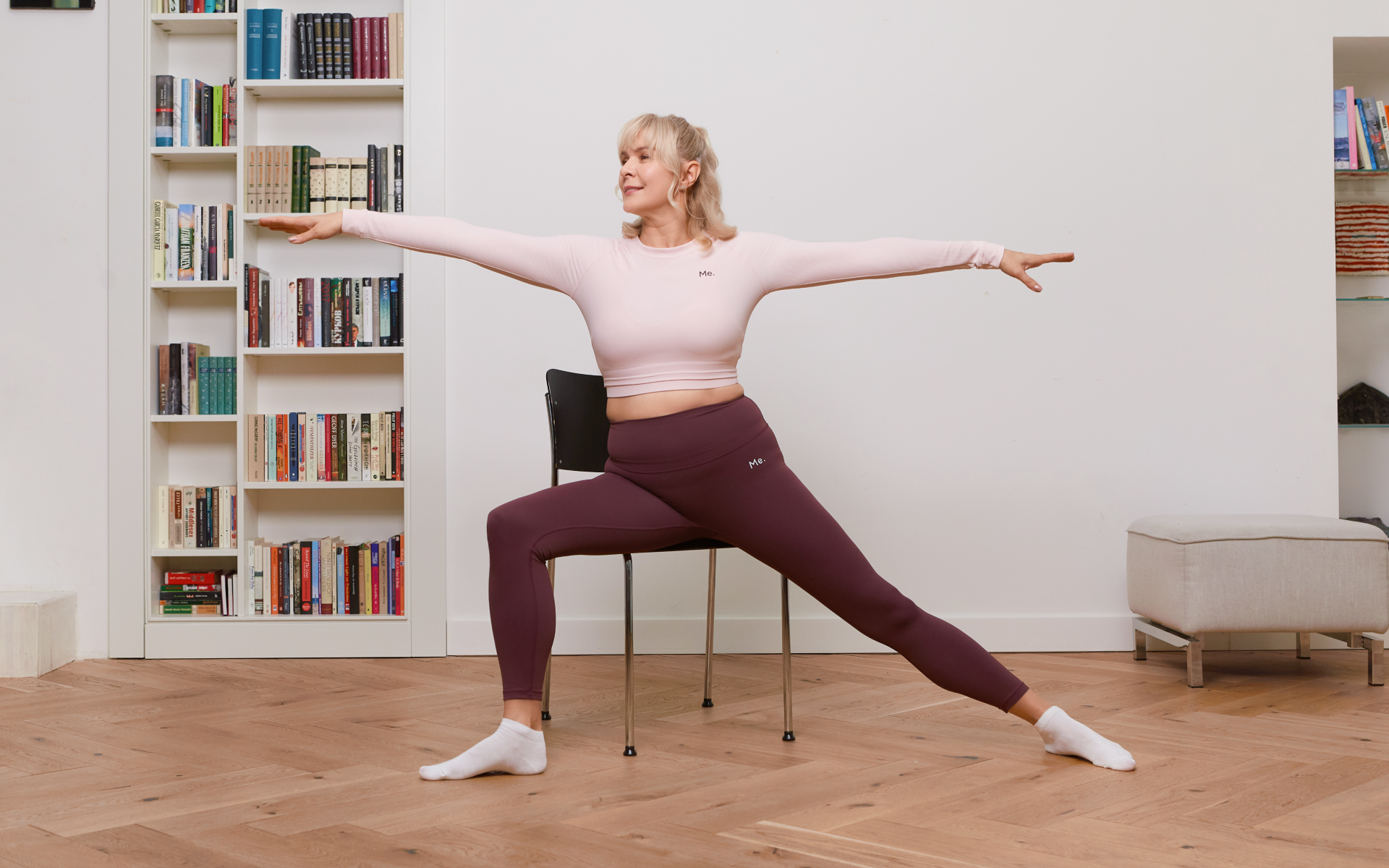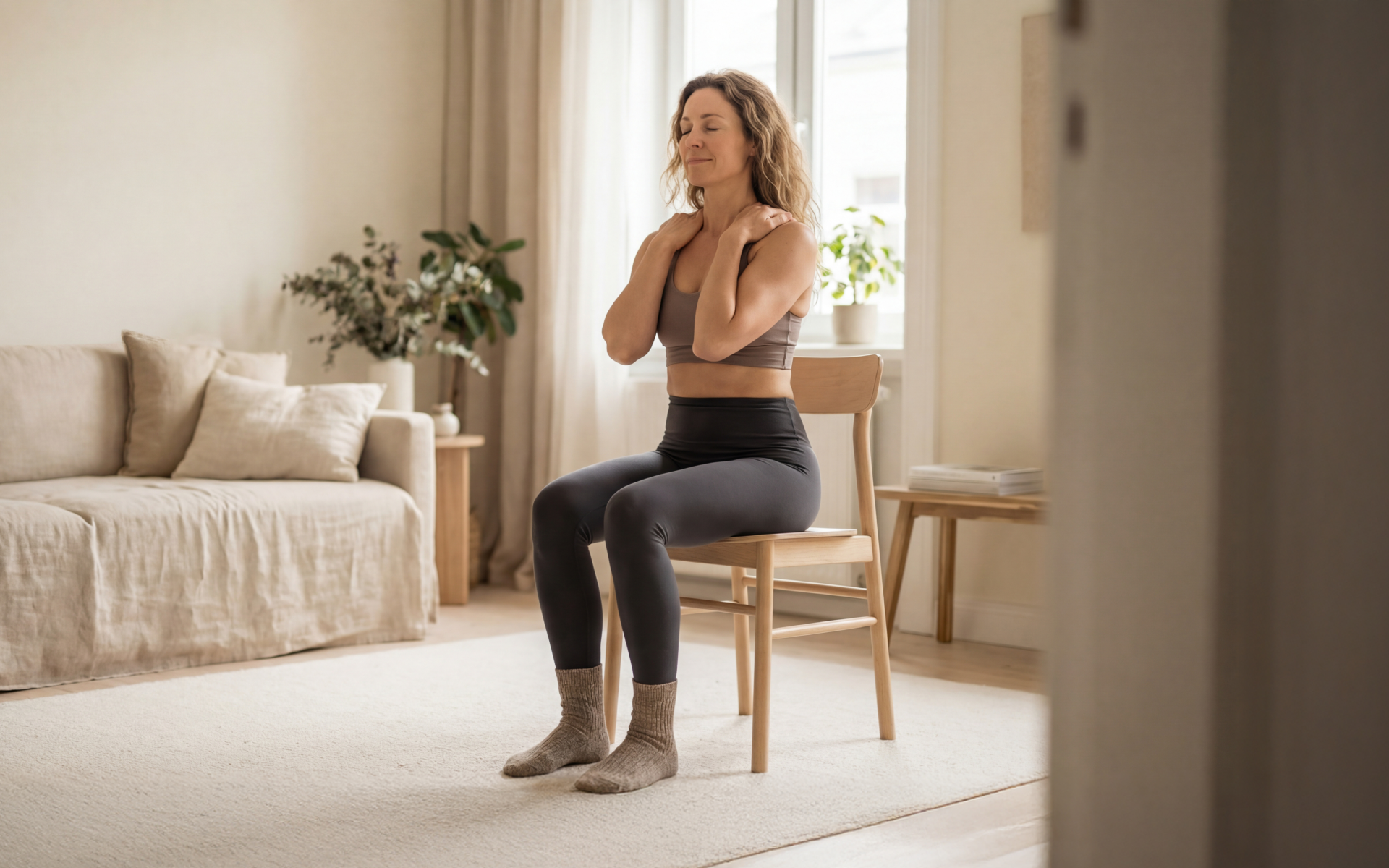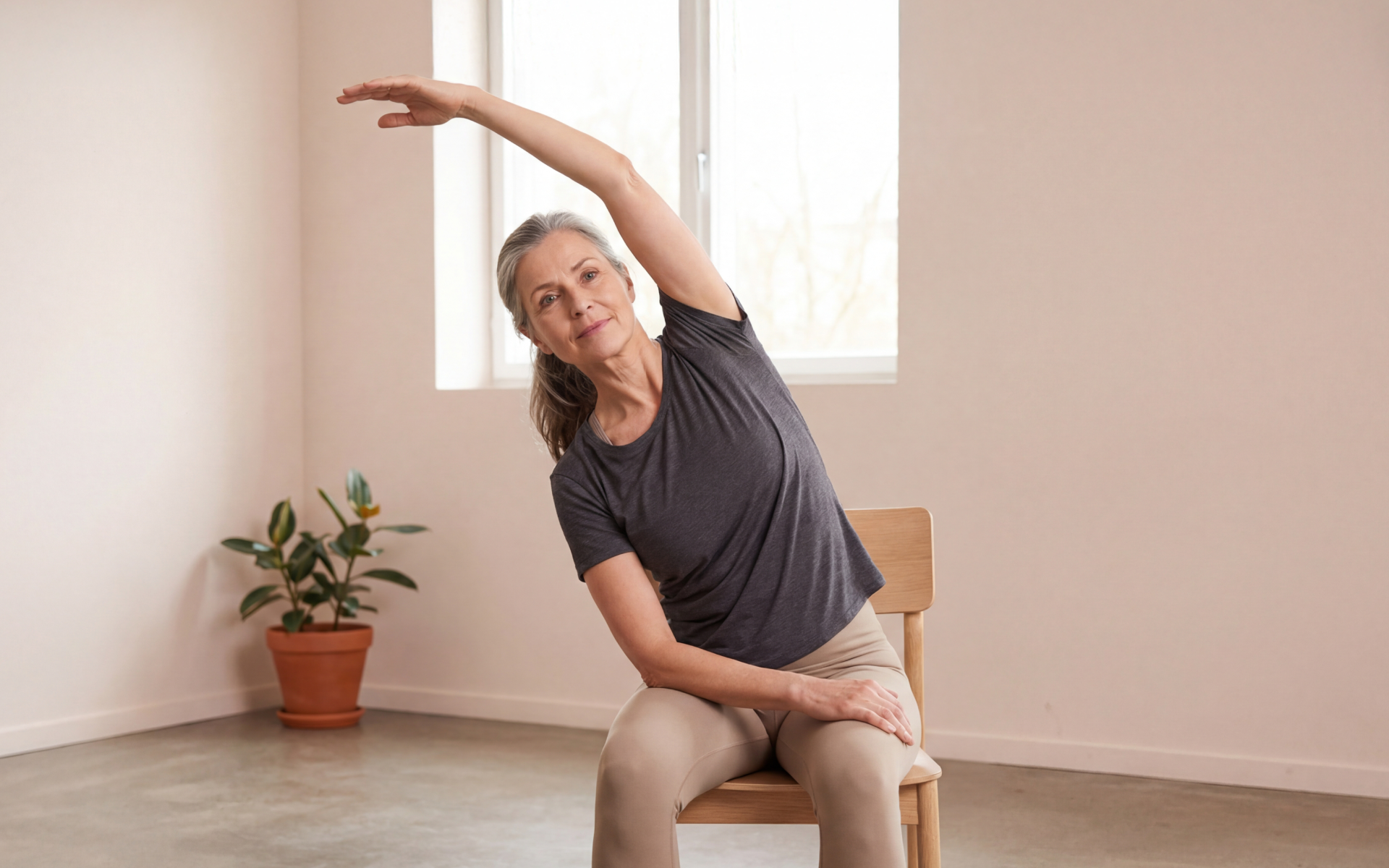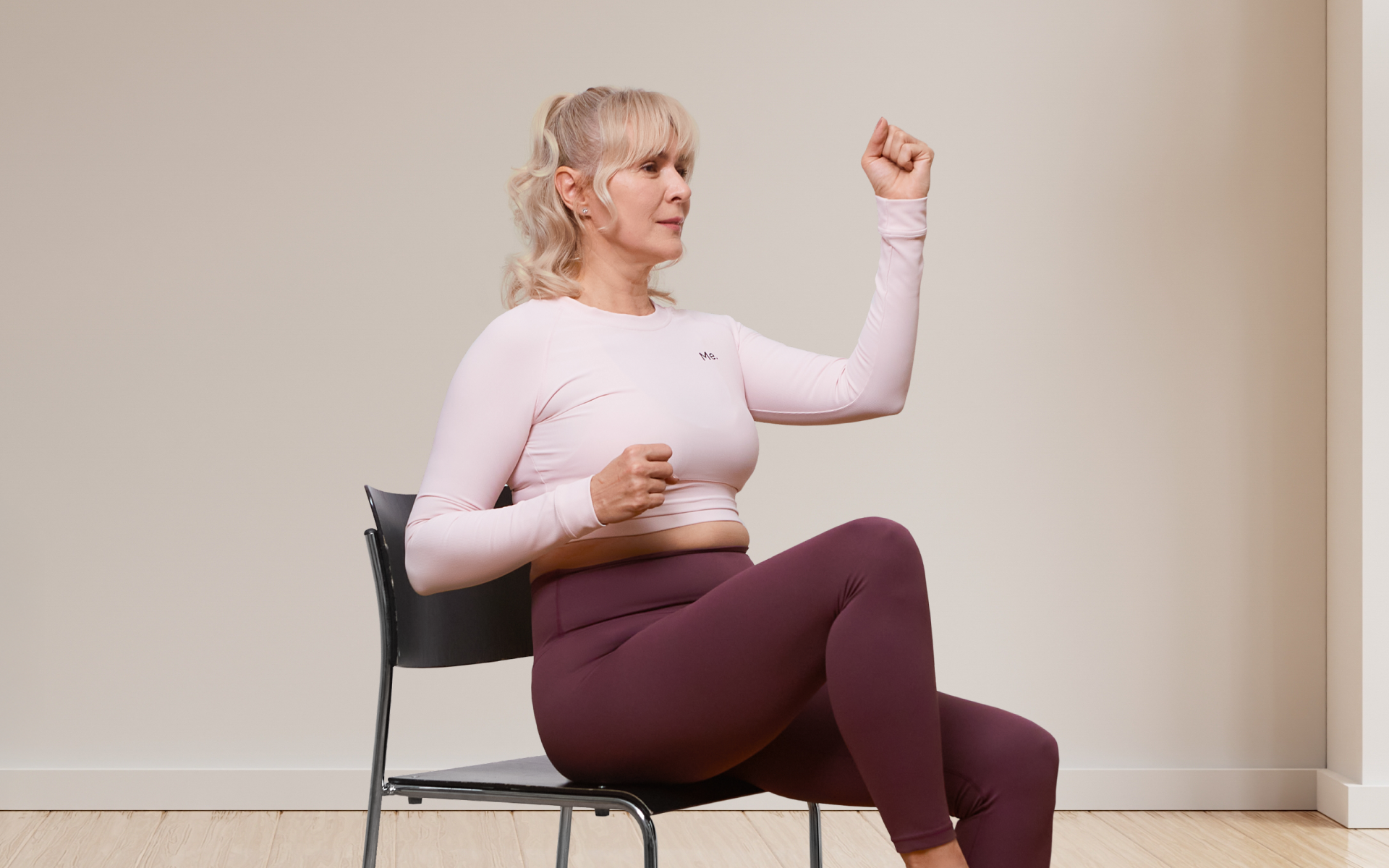In the last few decades, the ancient and complex Indian practice of yoga has found its place in the fitness world and become a global phenomenon. While it originally wasn’t a fitness practice – rather, more of a spiritual practice – yoga is now synonymous with complicated twists and poses that seem to require incredible levels of strength, mobility and flexibility. What happens if you would like to experience the renowned benefits of this practice, but are nowhere near the fitness and flexibility levels of models and influencers that we see all across social media? This is where chair yoga comes in. If you’d like to know ‘what is chair yoga?’, learn simple chair yoga exercises to do in the comfort of your home (or office), and even the endless benefits of this exercise, read on!
What Is Chair Yoga?
Often referred to as ‘gentle chair yoga’ or ‘seated yoga’, it is a gentle variation of yoga that is usually done while sitting down. It should be noted that while the majority of the poses in this variation are indeed done while seated, some chair yoga poses can be done while standing – in this case, the chair is used mostly for support.
What Is Chair Yoga Good For?
If you are not sure if this modified form of yoga is for you, here are some chair yoga benefits that may convince you to give it a try
- It’s accessible – While yoga is generally easily accessible to most – i.e. you do not need to go to a studio, have fancy/expensive equipment, or pay anyone to train you – most poses we see taught/practiced in traditional yoga are not easy to do for certain groups in society.
For example, people with limited mobility, disabled persons, those who live with chronic pain and are unable to stand or sit on the ground and older adults cannot do many of the poses we see all over social media.
- Beginner friendly – Chair yoga is not only for older adults or people with disabilities. Because it’s really easy and safe to do, it works great for beginners. One thing that people tend to forget is that, just because yoga is relatively easy to do, doesn’t mean that it doesn’t have some side effects.
Muscle injuries are a very real side effect of this practice. Doing gentle chair yoga will help your body and muscles get used to stretching which will prevent this issue down the line when you attempt normal or more complex yoga poses/sutras (2).
Read More: Beyond Traditional Asanas: Exploring The Art Of Wall Yoga Poses
- Can reduce pain, improve physical function and quality of life in older adults – Many seniors live with chronic pain caused by a variety of issues such as neurodegenerative and musculoskeletal conditions, arthritis and osteoarthritis as well as peripheral vascular diseases.
This pain impairs their physical function, which not only affects their quality of life but also leaves them in isolation – causing another slew of issues like depression, anxiety, cognitive impairment , etc. (4). A study published in 2016 in the Journal of the American Geriatrics Society found that chair yoga exercise can help older adults deal with and manage pain better.
In the study, older adults were divided into 2 groups – the first were assigned to do chair yoga and the second group were assigned a Health Education program. Both groups had to do each program for 45 minutes, twice a week for 8 weeks.
After the 8 weeks, researchers found that the senior chair yoga group had greater pain reduction and pain interference which lasted up to 3 months after the study. What’s more, the seniors also reported reduced fatigue and improved gait speed. All the seniors in the study experienced pain and reduced physical function due to suffering from osteoarthritis in their lower extremities (1).
- Can improve mental health – While yoga is now mainly seen as a form of physical fitness exercise, its origins can be traced back to more spiritual and meditative roots.
Studies over the years have shown that it can be used for therapeutic effects as well. When done right, yoga asanas/posture/poses create a great mind-body connection which can help with the alternative treatment of mental health issues like stress, anxiety, depression, irritability and other mood disorders (5, 16).
Interestingly enough, the practice can also help build self- confidence and fix body image issues, which are closely related to mental health (3). It is also useful for major degenerative mental illnesses like Parkinsons, multiple sclerosis, fibromyalgia and more (14, 6).
- Can help you sleep better – According to statistics provided by the Sleep Foundation, not only do a majority of adults get less than the recommended 7 or more hours of sleep per night, but most of them also tend to wake up tired and experience issues such as insomnia, sleep apnea and other disorders (9).
If you fall in any of the above groups, chair yoga some hours before bed, could help you sleep better. Research over the years has shown that meditation as well as breathing techniques in yoga can help people of all ages sleep better (13, 15, 7).
- Increased muscle tone and strength – When it comes to things like muscle toning and strength, weight lifting is the type of exercise mostly associated with this. However, since many older adults, people with disabilities or those living with chronic illnesses cannot lift heavy weights right off the bat, chair yoga is a great place to start.
In a meta analysis published in the International Journal of Environmental Research and Public Health journal in 2021, researchers found that senior chair exercise was a great way to improve physical ability, functions of daily living and slow progression of disease and disability in older adults.
Aside from this, their review of 17 studies with a total of 1388 participants helped conclude that chair-based exercise programmes like this one helped boost upper body strength and function (11).
A Simple Chair Yoga Sequence For Beginners
A yoga sequence is something used in many yoga classes across the world. It is described as the art of putting poses in a continuous and connected pattern that creates a simple flow from one posture to another.
Here is a simple chair yoga sequence that you can do at home – or during your break at work
Some points to note before starting:
- Any chair works – Just make sure that you are comfortable on it. Chairs with wheels are discouraged as they will mess with balance.
- Height of chair is important – Your legs should be comfortably planted on the ground during these poses. Adjust the height of your chair to allow this. If the chair isn’t adjustable, short people should place a block under the feet and taller people should consider finding a higher chair.
- Try sitting at the edge or in the middle of the seat. It makes it easier to navigate the multiple poses.
Whether you’re looking to simply pep up your fitness routine, jazz up your diet with mouth-watering low-calorie recipes or want to get your act together and significantly drop that number on your scale – BetterMe app has got you covered! Improve your body and revamp your life with us!
Seated Urdhva Hastasana
Seat with good posture on the chair. Keep the spine straight, core engaged and shoulders away from your ears. Slowly lift your arms towards the ceiling, hold for 3 seconds and then slowly lower them.
Seated Chakravakasana – Cat/Cow Pose
From the Urdhva Hastasana, place your hands on your knees – the top of your thighs works just fine if you can’t reach that far. On an inhale, lift your shoulders, and arch your spine towards your spine. At the end of the stretch, push your shoulders together as much as you can. This is the cat pose
Hold this position for a few breaths. On an exhale, round your shoulders and spine and drop your chin to your chest – creating a concave shape with your body. This is the cow pose.
Hold for a few breaths before coming back to the correct posture position. Rest for 3 seconds and then go into cat pose again.
Seated Uttanasana – Forward Bend
While in an upright position – back straight, shoulders down and hands hanging on either side of your body -, exhale and fall forward over your thighs. Let your head hang down comfortably. Your hands should be on the floor
Hold and then inhale, push off the floor with your hand and lift your torso back to the upright position. Repeat this motion several times
Seated Spinal Twist
Back in the upright position, take your left hand and place it on your right knee. Place the right arm over the back of your chair. Once in this position, turn to look over your right shoulder. With each inhale, you should feel your spine lengthen and every exhale should elicit a deeper twist. Hold this pose for a few breaths and try twisting deeper with each exhale.
After some time, exhale and come back to the center. Rest and then repeat on the other side.
Seated Bhujangasana – Cobra Pose
There are many ways to do this:
Option 1 – Place your hands on your knees then lean forward and stick your chest out. Inhale and lift the middle of your chest while simultaneously raising your chin. Stop once your gaze lands on the ceiling and you can feel a nice stretch in the middle of your back. Remember to keep your shoulders away from your ears. If you feel a stretch in your chest and spine, then you are doing well. Hold this position for a few breaths and then on an inhale, come back down to the original position.
Option 2 – While seated in an upright position, reach back with both hands and hold the back of your chair. This pushed the chest out and upwards, stretching the spine. Change the position of the hands either upwards, downwards or even sideways to increase or decrease the stretch.
These are just some simple seated poses to get you started. The positions and poses that can be done with chair yoga are endless.
Read More: Sit Your Way To Wellness: Unravel The Benefits Of Chair Yoga
FAQs
What Is A Yoga Ball Chair?
A yoga ball chair is simply -a stability ball or exercise ball often found and used in gyms. In the gym, this ball can be used during a variety of workouts like squats, stretching, and a number of core exercises.
Back in 2020 and 2021, the yoga ball chair became a trend as people claimed that swapping your couch or regular office chair for this exercise ball would help improve your posture, relieve back pain, and even give you a subtle core workout during the day.
However, these claims were quickly debunked as research came out showing that sitting for prolonged time on these balls
- Did not provide any core activation – A study from 2015, showed that your core works the same whether you sit on a ball or just a regular chair (12).
- Will very likely worsen posture and increase back pain – The key to correct sitting posture is good back support – a yoga chair ball doesn’t have this – meaning you will very likely end up slouching.
A study published in 2009 showed that people who sat on an exercise ball experienced spinal shrinkage (10). Spinal shrinkage (aka spinal stenosis) reduces that space inside the backbone which then places pressure on the spinal cord and nerves that travel through the spine. Slumping the lower back is one of the causes of low back pain – if you suffer from low back pain and continue to slump/slouch, you will worsen this pain to chronic levels
Another study published in 2012 in the Journal of Occupational and Environmental Hygiene, showed that 42 percent of participants reported increased back pain after using the stability ball as a chair (8).
- Will increase your risk of injury – At the end of the day, these balls are very unstable. Chances are that one day you’ll end up falling over while sitting, trying to sit or standing up from it. No one wants that level of embarrassment in the office.
Using an exercise ball isn’t all bad though. It can be used – for short periods – by pregnant people, people dealing with hemorrhoids, and those who just gave birth in the past 6 weeks.
If you struggle to even flirt with the idea of giving up your favorite foods or working out till your legs give way – BetterMe app is here to breathe a fresh perspective into the way you view the weight loss process! Check out the app and experience the fun side of fitness and dieting with BetterMe!
What Is Chair Yoga Exercise?
These are yoga exercises modified and done while seated on a chair – or while standing and using your chair of choice for balance.
What Is Chair Pose Yoga?
If you are wondering ‘what is chair pose yoga?’ or ‘what is gentle chair yoga?’, it is as discussed in the article above.
The Bottom Line: What Is Chair Yoga?
Chair yoga is a modified gentle version of regular yoga. This variation makes this ancient mind-body practice more accessible to the sick, elderly and disabled. It can also be used by student, officer workers, work from home employees – and basically anyone who spends hours seated to give their back a stretch. While chair yoga is more gentle than the original, it still has the same benefits as regular yoga. Try it today!
DISCLAIMER:
This article is intended for general informational purposes only and does not serve to address individual circumstances. It is not a substitute for professional advice or help and should not be relied on for making any kind of decision-making. Any action taken as a direct or indirect result of the information in this article is entirely at your own risk and is your sole responsibility.
BetterMe, its content staff, and its medical advisors accept no responsibility for inaccuracies, errors, misstatements, inconsistencies, or omissions and specifically disclaim any liability, loss or risk, personal, professional or otherwise, which may be incurred as a consequence, directly or indirectly, of the use and/or application of any content.
You should always seek the advice of your physician or other qualified health provider with any questions you may have regarding a medical condition or your specific situation. Never disregard professional medical advice or delay seeking it because of BetterMe content. If you suspect or think you may have a medical emergency, call your doctor.
SOURCES:
- A Pilot Randomized Controlled Trial of the Effects of Chair Yoga on Pain and Physical Function Among Community-Dwelling Older Adults With Lower Extremity Osteoarthritis (2016, agsjournals.onlinelibrary.wiley.com)
- Benefits and adverse effects associated with yoga practice: A cross-sectional survey from India (2021, pubmed.ncbi.nlm.nih.gov)
- Body image and self-esteem (2016, psycnet.apa.org)
- Chronic Pain in the Elderly: Mechanisms and Perspectives (2022, ncbi.nlm.nih.gov)
- Exploring the therapeutic effects of yoga and its ability to increase quality of life (2011, ncbi.nlm.nih.gov)
- Functional Improvements in Parkinson’s Disease Following a Randomized Trial of Yoga (2018, hindawi.com)
- Impact of long term Yoga practice on sleep quality and quality of life in the elderly (2013, ncbi.nlm.nih.gov)
- Sitting on Stability Balls: Biomechanics Evaluation in a Workplace Setting (2012, tandfonline.com)
- Sleep Statistics (2023, sleepfoundation.org)
- Static and dynamic postural loadings during computer work in females: Sitting on an office chair versus sitting on an exercise ball (2009, sciencedirect.com)
- The Effect of Chair-Based Exercise on Physical Function in Older Adults: A Systematic Review and Meta-Analysis (2021, mdpi.com)
- Unstable Sitting in the Workplace—Are There Physical Activity Benefits? (2015, journals.sagepub.com)
- Yoga and Sleep (2022, sleepfoundation.org)
- Yoga as Therapy for Neurodegenerative Disorders: A Case Report of Therapeutic Yoga for Adrenomyeloneuropathy (2014, ncbi.nlm.nih.gov)
- Yoga for improving sleep quality and quality of life for older adults (2014, pubmed.ncbi.nlm.nih.gov)
- Yoga in Public School Improves Adolescent Mood and Affect (2014, link.springer.com)
